
© 2017 The Association for Water and Rural Development
RESILIM-O:
Resilience in the Limpopo Basin
Program– Olifants
MILESTONE 1: Inception Report
Under the
Lower Olifants catchment
Agricultural Support Initiative
(AgriSI)
13/04/2018

MILESTONE 1: INCEPTION REPORT
| 2
Acknowledgements
The USAID: RESILIM-O project is funded by the U.S. Agency for International Development under
USAID/Southern Africa RESILIENCE IN THE LIMPOPO BASIN PROGRAM (RESILIM). The RESILIM-O project is
implemented by the Association for Water and Rural Development (AWARD), in collaborationwith partners.
Cooperative Agreement nr AID-674-A-13-00008.
© Association for Water and Rural Development (AWARD)
P O Box 1919
Hoedspruit 1380
Limpopo, South Africa
T 015-793 0503
W award.org.za
Company Reg. No. 98/03011/08
Non-profit org. Reg. No. 006 –821

MILESTONE 1: INCEPTION REPORT
| 3
ABOUT USAID: RESILIM
USAID’s Resilience in the Limpopo River Basin (RESILIM) program addresses ongoing degradation in the
Limpopo River Basin in southern Africa, where people face water shortages, increased floods, and declines
in crop productivity as climate change further stresses an already water limited region.
There are two components to the program; one operating at a basin-scale (RESILIM-B, which isimplemented
by USA-based Chemonicsand addresses similar issues at the scale of the four SADC member states that share
the Limpopo Basin (South Africa, Botswana, Zimbabwe and Mozambique) and acatchment-scale project
(RESILIM-O)that It is being implemented by the Association for Water and Rural Development (AWARD).
Both projects share the same overall objectives. You can find out more information on the RESILIM projects
on www.usaid.gov website and www.award.org.za.
The USAID’s RESILIM-O focusses on the Olifants catchment. The program aims to reduce the vulnerability of
people and ecosystems inthe Olifants Catchment specifically, by improving how transboundary natural
resources are managed. By understanding the systemic causes of vulnerability, including climate
vulnerability, it is promoting new ways of thinking and acting to promote integrated water and biodiversity
management.
ABOUT AWARD
At AWARD, we recognize that the natural world’s resources are limited, and undergoing rapid depletion and
transformation. We know current practices of useand management are inadequate to deal with the changes
and challenges we are facing. We design practical interventions to address the vulnerability of people and
ecosystems, and merge considerations from both environmentaland social perspectives. Our approach
involves thinking across disciplines, boundaries and systems.
We are working with diverse people and institutions in the water and biodiversity sectors in the Olifants
River Catchment to understand the multiple vulnerabilities to change, including climate change. Along with
quality scientific contributions, our engagement in the socio-political context of the Olifants River
Catchment allows us begin to begin to institutionalize integrated, resilience-based practices, providing a
foundation for robust development policy and practice in the in this river catchment, and beyond
1
.
The Olifants Catchment: An overview
The Olifants River Catchment falls within the Limpopo River Basin, which is part of an international drainage
basin that stretches across South Africa, Mozambique, Zimbabwe and Botswana. In fact, the Olifants River
contributes nearly 40% of the water that flows in the Limpopo Rivermaking it an important catchment in
the system as a whole
2
.
1
AWARD: Annual Report.2016/2017 Financial Year. RESILIENCE IN THE LIMPOPO – OLIFANTS.10/31/2017
2
As above

MILESTONE 1: INCEPTION REPORT
| 4
AWARD, 2017.
At the heart of this catchment is the Olifants River, a vital artery that flows for 560 kilometres through
South Africa and into Mozambique, where it is known as the Rio dos Elefantes in Mozambique.
This mighty river originates in South Africa’s MpumalangaHighveld, flowing northwards before curving in an
easterly direction through the Kruger National Park and into Mozambique, finally finding rest in the salty
water of the Indian Ocean near Xai Xai, just north of Maputo.
The main tributaries of the Olifants River are the Wilge, Elands, Ga-Selati, Klein Olifants, Steelpoort, Blyde,
Klaserie and Timbavati Rivers.
Along with its tributaries, it is one of the six major Lowveld river systems, occupying an area just short of
55 000 square kilometres. It traverses three provinces in South Africa; Gauteng, Mpumalanga and Limpopo.
About 3.5 million people live on the South African side of the catchment. In Mozambique, it flows through
Gaza Province, which is home to about 700 000 people.
A system under change
Our catchment is the foundation of our livelihoods and development. Yet the river and associated natural
resources in the Olifants Catchment are under threat.
Unchecked pollution, inappropriate land resource use, weak and poorly enforced policies and regulations
and poor protection of habitats and biodiversity are degrading the Olifants at an alarming rate. What’s more,
the area is however under threat from factors such as mining for heavy metals, inappropriate land
management, rural sprawland unsustainable useof natural resources. This affects the level of goods and
services provided by the ecosystem.
The diverse population groups living in the Olifants Catchment all have one thing in common; they rely on
the river and the catchment’s natural biodiversity fortheir livelihoods. This reliance can be direct or indirect.
Rural communities rely onit for things such as traditional medicine, grazing and browse, fuel, food and
housing materials. Some people in river-sidecommunities harvest reeds, collect water fromthe river for

MILESTONE 1: INCEPTION REPORT
| 5
washing and drinking and use it for recreational and spiritual practices. Subsistence farmers in Mozambique
rely heavily on the catchment’s flood plains. There are also large mines and associated industries, large
scale agriculture and the wildlife economy, which all rely on a healthy, functioning river system. Often
people forget that what they do upstream affects people down stream, sometimes with dire consequences.
The catchment isour home and it isworth investingin its future. The work reported here is part ofthe
ongoing activities of the RESILIM- O project under the grant from USAID: Southern Africa.

MILESTONE 1: INCEPTION REPORT
| 6
Project partners
Mahlatini Development Foundation (MDF) isa small public benefit non-profit organization consisting of rural
development practitioners who specialize in participatory learning and action processes, sustainable natural
resource management and low external input farming systems, including a focus on rain water harvesting,
conservation agriculture, intensive homestead food production, food security, climate change adaptation
micro finance and enterprise development.
MDF designs and implements rural developmentprogrammes and training processes providing learning
processes for adults all the way fromsemi-literatefarmers to post graduate university level. We work in
partnership with government and non-government organisations alike. We are sensitive to and mainstream
where possible gender, disability and people living with HIV/AIDs

MILESTONE 1: INCEPTION REPORT
| 7
Contents
Table of Contents
1 Executive Summary.........................................................................................................9
1.1 Progress for the reporting period...................................................................................9
2 Project Objectives..........................................................................................................9
2.1 Overview of RESILIM-O Project objectives.........................................................................9
2.2 Sub-grant Project Objectives......................................................................................10
3 Theory of Change..........................................................................................................10
4 Milestone Description .....................................................................................................16
4.1 Definition of milestone and purpose ..............................................................................16
5 Project management plan...............................................................................................19
5.1 Summary of project implementation process...................................................................19
6 Monitoring, evaluation, learning and reporting (MERL) plan......................................................20
6.1 Draft framework & indicators......................................................................................20
6.1.1 Baseline ............................................................................................21
6.1.2 Ongoing monitoring ...............................................................................21
6.1.3 Evaluation ..........................................................................................21
7 Media and communications strategy...................................................................................21
8 Sub-grant protocols and procedures...................................................................................22
9 Approach/ Process/ Activities..........................................................................................24
9.1 Summary of activities...............................................................................................24
9.2 Progress and Results ................................................................................................. 24
9.2.1 Learning and mentoring .........................................................................24
9.2.2 Innovations and Experimentation ..............................................................26
9.2.3 Work Plan for 2018. ..............................................................................28
10 Appendices................................................................................................................30
10.1 Appendix 1: Gannt Chart AgriSi 2018-2019.....................................................................30
10.2 Appendix 2:..........................................................................................................33
13.3 Appendix 3: Homestead assessment monitoring sheet (baseline).........................................36
13.4 Appendix 4: Garden monitoring and individual experimentation plan....................................42
13.5 Appendix 5: Attendance registers for CA demonstration workshops: December 2017- Turkey,
Mametje and Botshabelo. ...............................................................................................44
13.6 Appendix 6: Establishment of CA trial or experimental sites...............................................45

MILESTONE 1: INCEPTION REPORT
| 8
13.6.1 Trial size and layouts ...........................................................................45
13.6.2. Progress of Koko Maphori’s trial plots.......................................................45
13.6.3 Monitoring of CA trials ..........................................................................46

MILESTONE 1: INCEPTION REPORT
| 9
1Executive Summary
1.1Progress for the reporting period
Continuation from reporting for final quarter of 2017 (Milestone 7):
•Initiation of a new learning group in Sedawa-extension (Turkey; 1st training workshop
•Re-introducing Conservation Agriculture to a larger group of participants, including cover crops –
sunflower, millet/sorghum and cowpeas.
•Set up of quantitative measurement instrumentation for CA trials and tunnels
The proposal for continuation of the AgriSi programme has been developed and submitted. This inception
report includes the finalised implementation plans, project management plans and MERL framework
IMPLEMENTATION TEAM
MAHLATHINI: Erna Kruger, Sylvester Selala, Nozipho Zwane (Intern), Betty Maimela (intern)
AWARD: Cryton Zazu, Bigboy Mkhabela,
2Project Objectives
2.1Overview of RESILIM-O Project objectives
RESILIM-O is large multi-faceted, multi-stakeholder, cross-boundary programme to reduce vulnerability to
climate change through building improved transboundary water and biodiversity governance and
management of the Olifants Basin through the adoption of science-based strategies that enhance the
resilience of its people and ecosystems through systemic and social learning approaches. The programme
has been running for five years and is being implemented by AWARD (The Association for Water and Rural
Development) with funding from USAID.
The Agricultural Support Initiative (AgriSI) was initiated as a sub-grant process within the larger
programmed towards the end of 2016. This initiative works specifically with climate change adaptation
processes with smallholder communities in the lower Olifants River basin. It is being implemented jointly
by Mahlathini Development Foundation and AWARD.
The Agricultural Support Initiative (AgriSI) addresses two of the RESILIM-O programme objectives directly:
i.To institutionalize systemic, collaborative planning and action for resilience of ecosystems and
associated livelihoods through enhancing the capacity of stakeholders to sustainably manage natural
resources of the Olifants River Basin under different scenarios
ii.To reduce vulnerability to climate change and other factors by supporting collective action, informed
adaptation strategies and practices and tenable institutional arrangements.

MILESTONE 1: INCEPTION REPORT
| 10
2.2Sub-grant Project Objectives
Sound agro-ecological practices for soil and water conservation (SWC) and the ability to self-organise and
act collectively are regarded as fundamental for building adaptive capacity and resilience to climate
change. Not only do agro-ecological farming approaches require minimum external inputs – which may be
expensive and increase dependency if subsidised –but they foster farmers’ sense that they can build
sustainable futures from local inputs and efforts. With knowledge about the potential impacts of climate
change included in the learning journey, farmers can make purposeful decisions around practices such as
seed and crop-type. This approach supports livelihood diversification – also fundamental for increased
resilience –through ‘value-added’ associated activities such as seedling production, tree nurseries and
bee-keeping.
The overall aim of the Agricultural Support Initiative is to enhance the resilience of the people and
ecosystems in selected villages (5-6) in the Lower Olifants River basin, using a systemic social learning
approach, exploring the question:What are you learning about the socio-economic and biophysical
characteristics of your environment and how these are changing and how are you able to respond to that?
The overarching objective of this work is to provide support for increased adaptive capacity and resilience
to the effects of climate change for households involved in agriculture in select communities of the
Olifants River Catchment through:
- Improved soil and water conservation and agro-ecological practices for increased food security
- Livelihood diversification and supplementation through alternative climate resistant production;
- Increased community empowerment as a result of self-organisation and collective action.
-
3Theory of Change
The Theory of Change (Figure 1) captures the key pathways to the intended outcome and remains the
same for the proposed 2nd year of implementation.

MILESTONE 1: INCEPTION REPORT
| 11
Below is a table outlining the theory of change for the AgriSi (Pahse 2) process for 2018-2019
Figure 1: Project Theory of Change
Increased resilience to the effects of
climate change at the household
level in target communities
Increased food
security at
household level
Family livelihoods
diversified and
supplemented through
alternative climate
resistant production
Increased community
empowerment
through self-
organisation and
collective action
Training
Skills transfer
Demonstration Plots
Climate-change literacy
Agro-ecological processes and inputs
Group Formation and action
Climate Smart Agriculture Champions
Climate change
Literacy and adaptation
enhanced

MILESTONE 1: INCEPTION REPORT
| 12
THEORY OF CHANGE:
Overall
Objectives
KRA 1: To institutionalize systemic, collaborative planning and action for resilience of ecosystems and associated livelihoods
through enhancing the capacity of stakeholders to sustainably manage natural resources of the Olifants River Basin under
different scenarios
KRA 4: To reduce vulnerability to climate change and other factors by supporting collective action, informed adaptation
strategies and practices and tenable institutional arrangements
AgrSI (Phase 2)
Objective
To provide support for increased adaptive capacity and resilience to the effects of climate change for households involved in
agriculture in select communities of the Olifants River Catchment
Objectives
Key
activities
Activities
Outputs/
milestones
Outcomes/
deliverables
Verifiable
indicators
Climate change
indicators
Targets
Increased
community
empowerment
as a result of
self-
organisation
and collective
action.
Visioning
and decision
support
Initial introductions,
baseline information,
climate, soil and water
mapping (past,
present, future),
Community
participation
profiles. Baselines
for all participating
households.
Community level
analysis and increased
understanding of
climate change.
Linkages with local
stakeholders
Baseline
reports for
new village/s
2:4.8.2-14: Using
CC information or
vulnerability
assessments to
inform decisions
and actions.
Developing a plan
of action to
respond to and
build resilience to
climate change
impacts.
~125
participants
Visioning and scenario
development
Climate change
maps for
participating
villages
Exploration of the SES
under different future
scenarios,
collaborative
understanding of
climate change
impacts.
2-3 Scenarios
developed at a
local level with
baskets of
options for
best practice
Climate
change
adaptation
scenarios and
decision
making
reports -x 3
Learning group and
Local facilitator (LF)
mentoring and
support
Learning groups
and local
facilitators/champi
ons identified,
Capacity building for
learning groups and
LFs; incl savings, group
activities, community
awareness,
Progress
reports
6-7 learning
groups 6 CC
champions(LFs
)

MILESTONE 1: INCEPTION REPORT
| 13
functioning and
agency developed
Networking
and cross
visits
Seasonal review and
planning sessions for
each learning group.
Open days for
showcasing activities
and creating
awareness in the
broader community.
Seasonal review
and planning
sessions. Open day
programmes and
events,
Increased awareness
and community level
organisation;
collective action
Seasonal
review and
planning
reports (x3).
Open day
programmes
and summary
reports (2)
3:4.8.2-26. Number
of stakeholders
with increased
capacity: use
climate information
in decision making;
With increased
knowledge of
climate change
impacts and
response options.
35% of
participants
show
increased
knowledge
and response
Cross visits between
learning groups in the
lower and middle ORB
and linking to and
taking part in other
stakeholder
networking activities
Cross visits
conducted inside
the ORB(1-2)
Cross visit
summary
report (1-2)

MILESTONE 1: INCEPTION REPORT
| 14
Improved soil
and water
conservation
and agro-
ecological
farming
practices for
increased food
security
Learning and
mentoring
4X day practical
homestead based
learning sessions (in
soil and water
conservation,
intensive homestead
food production and
conservation
agriculture) for each
of 3-5 learning groups.
Training outlines,
handouts,
materials and
reports (3grps x3
trainings
Improved, diversified
production. Soil and
water conservation
practices
implemented.
Training
reports.
Gardening
monitoring
reports.
Attendance
registers
45% of
participants
implement at
least 1 CC
adaptation
response, 25%
of participants
implement 2-3
responses and
5-10%
implement >3.
Final training
manual by
April 2017
Ongoing mentoring
and monitoring with
further learning and
support activities as
required and
requested (1
day/month x 12
months).
Introduction,
demonstration and
piloting of best
practice options
(new and local
ideas)
Monitoring of
implementation of
best practices at
household level.
Identification and
awareness raising
around local and new
best practice options
(at least 2 identified
and introduced)
Photo diaries,
case studies,
B2O reports
3:4.8.2-26. Number
of stakeholders
with increased
capacity: use
climate information
in decision making;
With increased
knowledge of
climate change
impacts and
response options;
Stakeholders
implementing
water saving
strategies;
Individuals
diversifying
incomes towards
5 case studies
developed
Livelihood
diversification
and
supplementatio
n through
alternative
climate
resistant
production and
Focus sessions on
climate change
aspects and
considerations to be
included here
(3/year).
Reports on 3
focus sessions,
that include at
least 2 new
and or local
best practice
options.
4 CC w/s
impact
summaries

MILESTONE 1: INCEPTION REPORT
| 15
alternative
income
production
options
less climate
sensitive activities
Experimenta
tion and
introduction
to
innovations
Individuals
undertake
experiments with
qualitative and
quantitative
monitoring.
S&WC and
agroecological
practices
implemented and
monitored for at
least 50 individuals
Monitoring of
implementation of
best practices at
household level. Final
review and reporting
of the
experimentation and
implementation
process.
Individual
experimentati
on plans, and
garden
monitoring
reports
Best practice
booklet by
July 2018
Visits from local
facilitators/champions
and ongoing
homestead food
production monitoring
(monthly for each
participant).
Local
facilitator
monthly
timesheets,
photos
Collaborative
work
Learning groups
undertake joint soil
and water
conservation works in
teams and implement
planned activities for
all households (3
days/month).
Provision of technical
and limited
infrastructural support
and incentives for
these activities.
S&WC and
practices
implemented and
monitored for
learning group
teams
Collaborative work
strengthen local
organisational and
facilitation capacity
and
Collaborative
S&WC works
catalogued
and reported
on. (Min of 3
sites)
35% of
participants
engage in
collaborative
work at least
once.

MILESTONE 1: INCEPTION REPORT
| 16
4Milestone Description
4.1Definition of milestone and purpose
Milestone descriptions have been developed for AgriSI (Phase 2) for the period starting April 2018 and
ending October 2019.The table below summarises these activities against the milestones and indicates due
dates of these milestones.
Table 1: Mahlathini Development Foundation Milestone Schedule: March 2018-October 2019
Milestone Title
Activity
Outputs
Verification
Due
Date
1.Inception
AWARD:
R105,423.97
MDF:
R34,285.71
i.Update project
proposal.
ii.Develop MERL
Framework including
theory of change.
iii.Update project
implementation plan
with indicators and
targets.
iv.Project
Management plan.
v.Consolidate project
activities for phase 1
i.Inception
report.
ii.Phase 1 final
report.
1.Inception report that
includes the
following:
i.Updated project
implementation plan.
ii.MERL Framework.
iii.Project
Management Plan.
2.Phase 1 final report.
•Reflection of
implementation
against planned
activities as per
proposal.
•Final overall MERL
data.
•Lessons learnt and
recommendations.
13 Apr
2018
2.Progress
Report No.
1
(Apr’18 –
Jun’18)
AWARD:
R162,237.39
MDF:
R34,285.71
i.Baseline new
learning group -
Turkey, Decision
support and planning
ii.Learning sessions;
review of S&WC and
CSA, for all groups (1
day).
iii.Individual
farmer
experimentation -
prioritized, garden
monitoring.
iv.LF training;
qualitative
quantitative
monitoring
v.Networking; Part
video
i.DSS process and
reports.
ii.training reports
iii.Monitoring
forms, LF
process,
iv.M&E
framework for
household level
measurements
and monitoring
v.Invitations,
Participatory
video, visual
aids
Milestone report as per
reporting template
provided by AWARD.
Annexes:
i.Vision and scenarios
record.
ii.Training outlines,
handouts, attendance
registers.
iii.Report, photos,
monitoring.
iv.Progress report.
v.Networking report;
part video
07 Jul
2018

MILESTONE 1: INCEPTION REPORT
| 17
3.Progress
Report No.
2
(Jul’18 –
Sept’18)
AWARD:
R238,086.62
MDF:
R34,285.71
i.Learning sessions;
review of S&WC and
CSA, for all groups (1
day), Seed saving
and seed banks, crop
calendars training-
all groups (1 day).
ii.Individual farmer
experimentation -
prioritized, garden
monitoring.
iii.Tunnel construction
iv.Cluster network
session; Impacts of
activities
i.Training
reports.
ii.Monitoring
forms, LF
process.
iii.Construction
process,
implementation.
iv.Combination of
learning groups,
LFs from
different
villages,
Milestone report as per
reporting template
provided by AWARD.
Annexes:
i.Training outlines,
handouts, attendance
registers.
ii.Report, photos,
monitoring.
iii.Progress report.
iv.Report
10 Oct
2018
4.Progress
Report No.
3
(Oct’18 –
Dec’18)
AWARD:
R149,929.35
MDF:
R34,285.71
i.Learning sessions;
Poultry production,
fodder
production(CA),
livelihoods
diversification (1 day
for selected groups.
ii.Individual farmer
experimentation -
prioritized, garden
monitoring.
iii.Cluster network
session; Impacts of
activities; Village
learning group open
day - 2 villages
i.Training
reports.
ii.Monitoring
forms, LF
process.
iii.Combination of
learning groups,
LFs from
different
villages,
Milestone report as per
reporting template
provided by AWARD.
Annexes:
i.Training outlines,
handouts,
attendance
registers.
ii.Report, photos,
monitoring.
iii.Progress report.
18 Jan
2019
5.Progress
Report 4.
(Jan’19-Mar’19)
AWARD:
R170,852,67
MDF:
R34,285.71
i.Baseline new
learning group, plus
initial review of
other new learning
groups. Decision
support and planning
5 learning groups.
ii.Learning sessions;
Fruit Production (1
day) - selected
groups.
iii.Individual farmer
experimentation -
prioritized, garden
monitoring.
iv.Qualitative and
quantitative
monitoring; tunnels,
TWH tanks, drip kits.
i.DSS process and
reports.
ii.Training reports
iii.Monitoring
forms, LF
process,
iv.M&E framework
for household
level
measurements
and monitoring.
Milestone report as per
reporting template
provided by AWARD.
Annexes:
i.Vision and scenarios
record.
ii.Training outlines,
handouts, attendance
registers.
iii.Report, photos,
monitoring.
iv.Progress report.
12 Apr
2019
6.Progress
Report No.
5
(Apr’19-Jun’19)
AWARD:
R154,203.66
MDF:
R34,285.71
i.Learning sessions;
Marketing, herbs for
all groups (1-2 days
per group).
ii.Individual farmer
experimentation -
prioritized, garden
monitoring.
i.Training
reports.
ii.Monitoring
forms, LF
process.
iii.M&E framework
for household
level
Milestone report as per
reporting template
provided by AWARD.
Annexes:
12 Jul
2019

MILESTONE 1: INCEPTION REPORT
| 18
iii.Qualitative and
quantitative
monitoring; tunnels,
RWH tanks, drip kits.
Garden monitoring.
iv.Cluster network
session; Impacts of
activities
measurements
and monitoring.
iv.Combination of
learning groups,
LFs from
different
villages,
i.Training outlines,
handouts, attendance
registers.
ii.Report, photos,
monitoring.
iii.Progress report.
iv.Report
7.Progress
report No. 6
and Final
Project
Report
(Jul’19 –
Sept’19)
AWARD:
R190,387.36
MDF:
R34,285.71
i.Learning sessions;
review of S&WC and
CSA, for all groups (1
day). Crop calendars
reviews
ii.Individual farmer
experimentation -
prioritized, garden
monitoring.
iii.Qualitative and
quantitative
monitoring; tunnels,
RWH tanks, drip kits.
Garden monitoring.
iv.Impact review
i.Training
reports.
ii.Monitoring
forms, LF
process.
iii.M&E framework
for household
level
measurements
and monitoring.
iv.Combination of
learning groups,
LFs from
different
villages,
1.Milestone report as
per reporting
template provided by
AWARD.
Annexes:
i.Training outlines,
handouts, attendance
registers.
ii.Report, photos,
monitoring.
2.Final Project Report
•Reflection on
implementation
against planned
activities as per
proposal.
•Final overall MERL
data
•Lessons learnt and
recommendations.
•Communication
materials.
18 Oct
2019

MILESTONE 1: INCEPTION REPORT
| 19
5Project management plan
The Mahlathini Development Foundation field team is to make biweekly trips to the area on a bimonthly
basis for the coming 18 month period. In addition, a process is being put in place for employment of an
intern that would be locally based and managed under the AgriSI team and manager at AWARD to provide
for continuity and assist with monitoring and fieldwork.
Implementation planning is to coincide with the milestones and a project implementation committee
consisting of all field based and management staff. These will meet at the end of each milestone (bi-
monthly) to do a review and planning forward session, work on progress towards indicators, compilation of
monitoring report and progress reports.
Bi-monthly reports will be compiled by the field team (Sylvester, Erna, intern) using the Monthly
Assessment Form (See Appendix 2). Progress reports according to the 6Milestones developed are to be
submitted as well. Additional documentation is to include the following where appropriate:
•Baselines; group and individual/homestead
•B2O reports; for each event (field team)
•Bi -monthly planning calendars and activity plans
•Bi-monthly team review summaries (field and management team) - MERL
•Garden monitoring forms (local facilitators and field team)
•Farmers self-assessment group process (2x/yr) (farmers, local facilitators, field team)
•Open days reports
5.1Summary of project implementation process
•In each of the 7 villages where learning groups have been established to date (Botshabelo,
Mametja, Sedawa, Turkey, Willows, the Oaks and Lepelle), MDF will continue the learning and
mentoring process according to review and planning for each group.
•This will include 3 days of training in soil and water conservation, gardening techniques (soil
management) and nutrition and livelihoods diversification as well as new topics identified by the
respective groups such as poultry production, planting calendars and seed saving.
•Each learning group will undertake:
1.A deepening of the climate change dialogues process to include assessment of practices
for impact on adaptation and resilience
2.In-depth qualitative and quantitative measurement of results of practices implemented
for assessment of impact and
3.Discussions and mentoring centred around livelihoods diversification options for learning
group members
•Participants undertake:
1.Individual farmer level experimentation processes.
2.Work together on joint activities identified by the group for broader scale land
rehabilitation and SWC (soil and water conservation).
3.Technical innovation demonstrations at collaboratively chosen homesteads such as rain
water harvesting and storage structures, small green houses and micro drip irrigation
systems.
4.Monitoring sessions to check how the implementation is going, from time to time (bi
monthly).
5.Cross learning visits to other villages doing similar work.

MILESTONE 1: INCEPTION REPORT
| 20
6.Open days and stakeholder involvement of for example the Ground Truth team,
Hoedspruit Hub, LIMA, the Local municipalities etc to engage in the CC adaptation
processes the participants are working with.
•Local facilitators support learning groups by doing garden visits and support for each participant
every month, to help with implementation of farmer experiments and also do garden level co-
monitoring. They provide a link between AWARD and community and assist with setting up
meetings and processes, arrange for joint working activities, help to identify the sites for
technical innovation demonstrations, provide logistical support and also provide a channel for
feedback from the community regarding process and implementation. They work 8-10 days per
month and receive a stipend of R200/day. Local facilitators will also come together for further
learning and monitoring sessions between themselves and be provided with opportunities for
deepening their own practice through cross visits as well as leadership courses and processes
supported inter alia by the Hoedspruit Hub.
The Gannt chart outlining the implementation plan is attached in Appendix 1
6Monitoring, evaluation, learning and
reporting (MERL) plan
6.1Final framework & indicators
(See Theory of Change above for targets and overall indicators)
In addition, regular (bi-monthly) summaries of progress using the following indicators will be made.
Indicator
Overall target
No of participants in learning groups
120
No of learning groups
6-7
No of local facilitators
6
Percentage of participants engaged in CC adaptation responses
1-2 (45%)
2-3 (25%)
>3 (10-15%)
No of participants experimenting with new innovations
-local
-co-designed
15%
45%
No of participants showing increased knowledge
35%
Percentage of participants engaged in collaborative activities
35%
Percentage of participants with improved livelihoods
-increased availability of food
-increased income
-increased diversity of activities and livelihoods options
40%
5%
5%
Qualitative assessments;
-stakeholder engagement
-Increased understanding and agency to act towards achieving
increased resilience
- Adaptation and innovations into local context
-Potential for increased resilience
-Social engagement
Stories, case studies (5), CC
impact summaries (4), best
practices booklet

MILESTONE 1: INCEPTION REPORT
| 21
6.1.1Baseline
- A baseline interview: (homestead assessment form – Appendix 3) that gives an indication of
present situation and implementation (not a full livelihoods questionnaire, but includes some
aspects of livelihoods).
- Facilitator observation checklist: Interviewers/ facilitators assist the household participant to
draw a homestead land use plan with present practices and flag issues and potential innovations
(what they are thinking of doing now) for the household. In addition, they make certain
observations that are needed for the overall planning processes
- Homestead drawing: This shows the whole homestead and present infrastructure, gardening,
water flow, erosion, other SWC management issues and present innovations and or activities (e.g.
jo-jo tanks, boreholes, furrows, orchard, etc.). This will be returned to the participant in a plastic
sleeve once copies are made- so that they can use that for planning their experimentation.
- A baseline report: Compilation of information from the group level climate change assessments,
five fingers, scenario development and design of CC assessment sheets
6.1.2 Ongoing monitoring
- Garden monitoring form (Monthly): (See Appendix 4) To be filled in monthly for each participant
by and with the local facilitator to assess CC adaptation and gardening implementation. These
compiled with photographs of the garden into
- Stories or case studies (5): Within the themes of managing adaptively, thinking systemically,
innovation towards positive change, self -organisation leading to collective action and learning
together. (for media and communications dissemination)
- Group reflections and open days (x5): Using the cc assessments and plans review progress and
also level of change and impact- incorporating defined indicators
- Project Team reflections (bi-monthly): Reflection on CC adaptation using indicators alongside
general progress, issues, learning and planning. (project implementation committee)
6.1.3 Evaluation
- Progress reports (x6) and final report - based on project deliverables and milestones.
Upon close out a final close out report stating zero continued financial responsibility from USAID will be
written
7Media and communications strategy
The function is largely around communicating the information from the sub-grant to AWARD.
MEDIA: media desk, clips, newspaper stories, small handbooks.
The particular area of practise with its indicators need to be communicated as stories (successes,
challenges -video clips). The elements of this reporting will be provided by AWARD.
The M&E – MERL plan go together. In bi- monthly reports we need to put in information about the type of
information this is.
.
Who will we be communicating with? Need to decide on the partners for this…
- SADC countries and issues here; board messages

MILESTONE 1: INCEPTION REPORT
| 22
- Interested audiences: Government departments, Municipalities – and messages to communicate
- Involved audiences; those interested and linked as stakeholders; Local economic development
desk, traditional authorities, water users associations, – messaging strategy
- Committed audiences – farmers we are working with. – are we producing handbooks and handouts,
other tools and PRA materials for example-personalised niche messaging
Products and Tools
- Digital: websites available – page of the project – new stories interesting things –“Our Olifants” –isa
social media platform for all role players. Civil society can put on their own information
- Digital: AWARD website is more formal
- Printed; booklets, briefs, flyers (not really for farmers) calling cards, banners, pullups, reports,
maps, ad hoc materials and support:
oProject brochure needs to be produced 4-8 pages – explains with pictures (Objectives, who
you working with…)
oReports; USAID branding; disclaimer, acknowledgements –public consumption not the
standard reports….may be at the end of the contract…
oBi-monthly reports; just summaries
oQuarterly report and annual reports - M&E report
oPhotos and profiles; stakeholder profiles (to go back to the farmer and track her story) – the
champions- local facilitators. -Folders on the computer… all photos must be properly
captioned.
oPhotos of the catchment; context river, soil, mountain, rain, farming…
oUser generated content; farmers, stakeholders
oMedia: AWARD will run this; media releases, special features (People’s Weather)
Print, electronic media and publicity products are required outside of the monthly, quarterly, etc.
reports, aligned very closely to the M&E budget (commitment).
Proposed products
- Case studies
- Open day and group reflection reports
Marking and branding
Marking and branding will follow provisions in Section M2 of the USAID FAA Standard Provisions as
appropriate.
8Sub-grant protocols and procedures
Overall, post-award administration requirements were presented and clarified by AWARD; in addition to
standard operating procedures. The following are specific highlights noted by MDF:
- Work always through AWARD. USAID may check records and also require a presentation to be made.
Also need access to records for milestone verification. All records etc. belong to USAID and need to
be submitted to them in full.
- Any after contract amendments of milestones (Dates and activities) have to go through USAID.
- Milestones: Documentation is sent to Cryton who does the verification of the documentation prior to
sending through to finance (Mayford and Julia) for payment. Site visits are a requirement – this will
probably be covered by work BB is doing.
- Payments: USAID pays out advance payments according to milestones – if milestones are going to
change – if timing changes- then we need to let USAID know. Approval for changes usually does not

MILESTONE 1: INCEPTION REPORT
| 23
take a long time. Invoice per milestone rather than actual expenditure- with supporting
documentation.

MILESTONE 1: INCEPTION REPORT
| 24
9Approach/ Process/ Activities
9.1Summary of activities
This section gives an indication of activities undertaken during the reporting period to achieve the
outcomes for this period, time spent and people involved.
Table 2: Summary of activities for the reporting period December 2017-January 2018.
DATE
DESCRIPTION OF ACTIVITY
Time
WHO WAS
INVOLVED
2017/12/04-08
CA demonstration workshops; turkey, Botshabelo,
Mametje
5 days
Sylvester
2017/12/11-15
Installation of instrumentation for quantitative
measurements: CA and tunnels
5 days
Sylvester
2018/01/08-09
Reporting
2 days
Sylvester
Sylvester: 12days
9.2Progress and Results
9.2.1Learning and mentoring
Conservation Agriculture demonstration sessions were held in three villages between 05-08 December
2017. In addition, small quantities of seed were provided to learning group members to undertake small
CA experimental plots in their own homesteads (OPV maize- yellow, sugar beans, jugo beans and summer
cover crops (sunflower)
The CA learning sessions included demonstration of hand held planters (MBLI planters) and an oxen drawn
(Napick) planter. These were left with learning group members to continue their individual planting.
The attendance registers for these workshops are attached in Appendix 5.
Below are a selection of photographs indicative of the learning and demonstration process.
Above left: The Turkey learning group in session for CA workshop. Above right: Sylvester demonstrating the use of
the Napik animal drawn planter

MILESTONE 1: INCEPTION REPORT
| 25
Above left: the turkey learning group planting the intercropping conservation agriculture demonstration, using basins
for maize and rows for beans. They are adding some lime and bone-meal to the planting stations and covering the
basins with leaves for mulching.
Above right; The group also opted to plant larger areas of single crop blocks - here they are planting maize in basins
Above left; The oxen drawn planter has been hitched to a
team of donkeys for planting.
Right; Distribution of cups of seed to participants for their
individual homestead based conservation agriculture
experiments
NOTE; Christina Thobejane and Alex Makgopa, the Local
Facilitators from Sedawa helped as co-facilitators for
this learning process. They were then able to play a lead facilitation role in the CA workshops conducted
subsequently in Botshabelo and Mametja
9.2.1.1 Demonstration of the Oxen drawn planter
The CA trials were established in big fields outside the homesteads, sometimes it’s difficult to plant these
big fields by hand. We have introduced an Oxen drawn planter as an option to those farmers who would
like to try CA on a relatively bigger scale. The people in the area do not have oxen, They use donkeys for
ploughing purposes and it has been a while since anyone has used donkeys for this purpose.

MILESTONE 1: INCEPTION REPORT
| 26
Some of the challenges were:
•Not being able to control the donkeys (they could not plant in a straight line, meaning it was hard
to maintain a consistent inter row spacing) – this could have been the case because the donkeys
were not well trained
•Changing discs in the planter, each of the participants wanted to learn technical things (hands on)
on the planter – this took too long
•Clays soil, in areas were soils have high clay content, the seed tine was blocked by the clay and
the planter was not planting – this helped use learn that once need to allow the soil to drain a bit
before planting with a oxen drawn planted
•Transporting the planter from one site to the other was a bit of a problem – the planter cannot fit
into a small bakkie, especially if the bakkie has a canopy.
Despite, the above mentioned challenges, participants liked the planter and felt it would be very useful to
have one in each of the villages. One of the participants in Turkey (Mr Mogofe) has committed to
purchasing one for himself. Mr Mogofe, has big field which he estimated to about 30 hectares, and he pays
R 1 000/ ha for tractor hire, but he’s got some donkeys which he can use with the planter
Above left and right: Planting the intercropping conservation agriculture demonstration sites for Mametja (6 Dec)
and Botshableo (8 December), respectively
In addition, three conservation agriculture trial sites were set up, so that more quantitative
measurements could be undertaken there. 1000m2 trials were planted; in Sedawa (Koko Maphori),
Mametja (Lerato Lewele) and Botshabelo (Seemole Malepe). See Appendix 6 for the CA trial layout report
9.2.2Innovations and Experimentation

MILESTONE 1: INCEPTION REPORT
| 27
The second week of December provided time to start installation of the instrumentation for more
quantitative measurements of water balances and water productivity for some of the experiments. This
information is meant to augment the farmers’ visual assessments and assist in determining impact of these
practices on adaptive capacity and building of resilience.
Rain gauges and run-off plots were installed
at the three CA farmer level CA trial plots
and gravimetric soil samples were taken .In
both setting up of instrumentation and
collection of data the two Local facilitators –
Christian Thobejane and Alex Makgopha will
play leading roles. They have been trained on
how to do the monitoring and data collection
processes and will undertake these on a
weekly and monthly basis as required.
Right: A run-off plot installed at Lerato Lewelle’s
field plot (Mametja) in her CA trial
Right: Christina Thobejane demonstrated taking the water from run-off
plots, where volume and turbidity are recorded. These measurements are
taken 1-2 days after each rainfall event.
For the vegetable production experimentation process, three
volunteers with tunnels were chosen and each has undertaken an
experiment of planting inside and outside their tunnel; using trench
beds, mixed cropping and mulching in both.
These experiments will then be monitored by the farmers visually for
growth and yield. They will record all irrigation in both plots (amount
of water applied). In addition quantitative measurements for water
availability are to be conducted using Chameleon sensors and further
data is to be recorded from the weather station set up at Christina
Thobejane’s homestead.
The pictures below indicate the installation of the weather station
and Chameleon sensors.

MILESTONE 1: INCEPTION REPORT
| 28
Right: Sylvester and Christina working
on setting up the weather station in
her yard and Far Right: Christina’s
daughter surveys the successfully
installed weather station.
Above Left: The soil auger used for gravimetric soil water sampling and for drilling the holes for the Chameleon
water sensors. Above centre: Sylvester installing a Chameleon sensor in a trench inside a tunnel. And Above right:
The automatic reader for water availability attached to the Chameleon sensor in a trench bed. These are uploaded
via the internet using cell phones on a weekly basis.
9.2.3Work Plan for 2018.
Continuation of activities into 2018-2019:
1.Negotiation for continuation of the process through AWARD for the coming year
2.Negotiation of a partnership with the WRC project on community level adaptation to ensure
continuation and co-funding of the process going forward (2-3 years) – albeit on a much reduced
level of implementation
3.Collaboration with Lima RDF in combining activities across the two programmes- their food
security and small business initiative and AgriSI. Training of facilitators in climate sensitive
facilitation and implementation of best options for good practices will be undertaken.
4.Continuation of garden monitoring and support for Local Facilitators and learning groups
5.Introduction of new facets such a VSLAs (Village Savings and Loan Schemes) and small livestock
production activities
6.Introduction of fodder production and management options for livestock.
7.A focus on seed saving, seed banks, cropping calendars, introduction of new varieties, and
varieties that are resistant to increasing temperatures and drought.

MILESTONE 1: INCEPTION REPORT
| 29
8.Mentoring and support for livelihoods diversification strategies
9.Limited support for a focus on fruit tree production, notably in Lepelle and Willows where
participants have requested trees.
10.Monitoring processes are to be put in place for management of the tunnels constructed and also
the 3 underground RWH tanks, alongside continued garden monitoring processes. Quantitative
measurements are to be undertaken to assess water productivity of some of the CSA practices
11.Village level cross visits for all participants to explore and interrogate the options for tunnels
and RWH storage, as well as other innovations introduced.
12.Use of participatory video as a tool to build agency in the villages for CCA activities and
communicate successes and issues with relevant stakeholders

MILESTONE 1: INCEPTION REPORT
| 30
10Appendices
10.1Appendix 1: Gannt Chart AgriSi 2018-2019
Activity
Marc
h
Apr
il
May
Jun
e
Jul
y
Aug
Sept
Oct
Nov
Dec
Jan
Feb
March
Apr
il
May
Jun
e
Jul
y
Aug
Sept
Oc
t
Desktop
stakeholder
analysis (for
Networking)
MDF: Set up Quant
mon for tunnels
and CA, 1st training
in Turkey,
Agroecology forum
Field visits
(baseline &
monitoring/suppor
t)
MDF: DSS-baseline,
2nd training turkey,
LF training,
Ukuvuna X visit,
start with further
tunnel
construction, Part
video training
DSS
baseli
ne
Part
Video
LF
trg
Organize
Networking
meetings X 2
MDF:, tunnels, 3rd
trg Turkey; 1stTrg
Sedawa, Finale,
Seed
savin
g
Crop
calendar
s, herbs
Ope
n
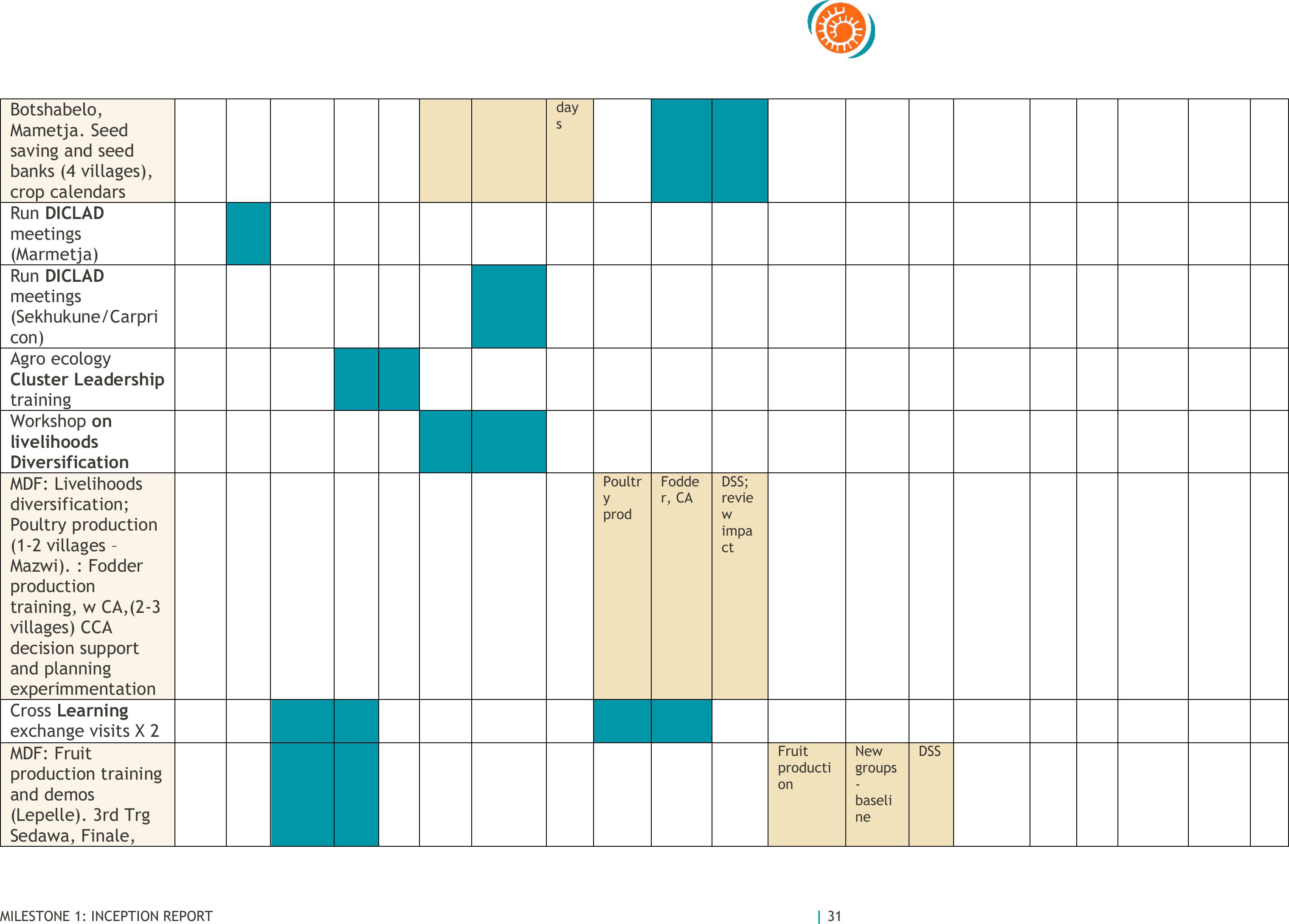
MILESTONE 1: INCEPTION REPORT
| 31
Botshabelo,
Mametja. Seed
saving and seed
banks (4 villages),
crop calendars
day
s
Run DICLAD
meetings
(Marmetja)
Run DICLAD
meetings
(Sekhukune/Carpri
con)
Agro ecology
Cluster Leadership
training
Workshopon
livelihoods
Diversification
MDF: Livelihoods
diversification;
Poultry production
(1-2 villages –
Mazwi). : Fodder
production
training, w CA,(2-3
villages) CCA
decision support
and planning
experimmentation
Poultr
y
prod
Fodde
r, CA
DSS;
revie
w
impa
ct
Cross Learning
exchange visits X 2
MDF: Fruit
production training
and demos
(Lepelle). 3rd Trg
Sedawa, Finale,
Fruit
producti
on
New
groups
-
baseli
ne
DSS
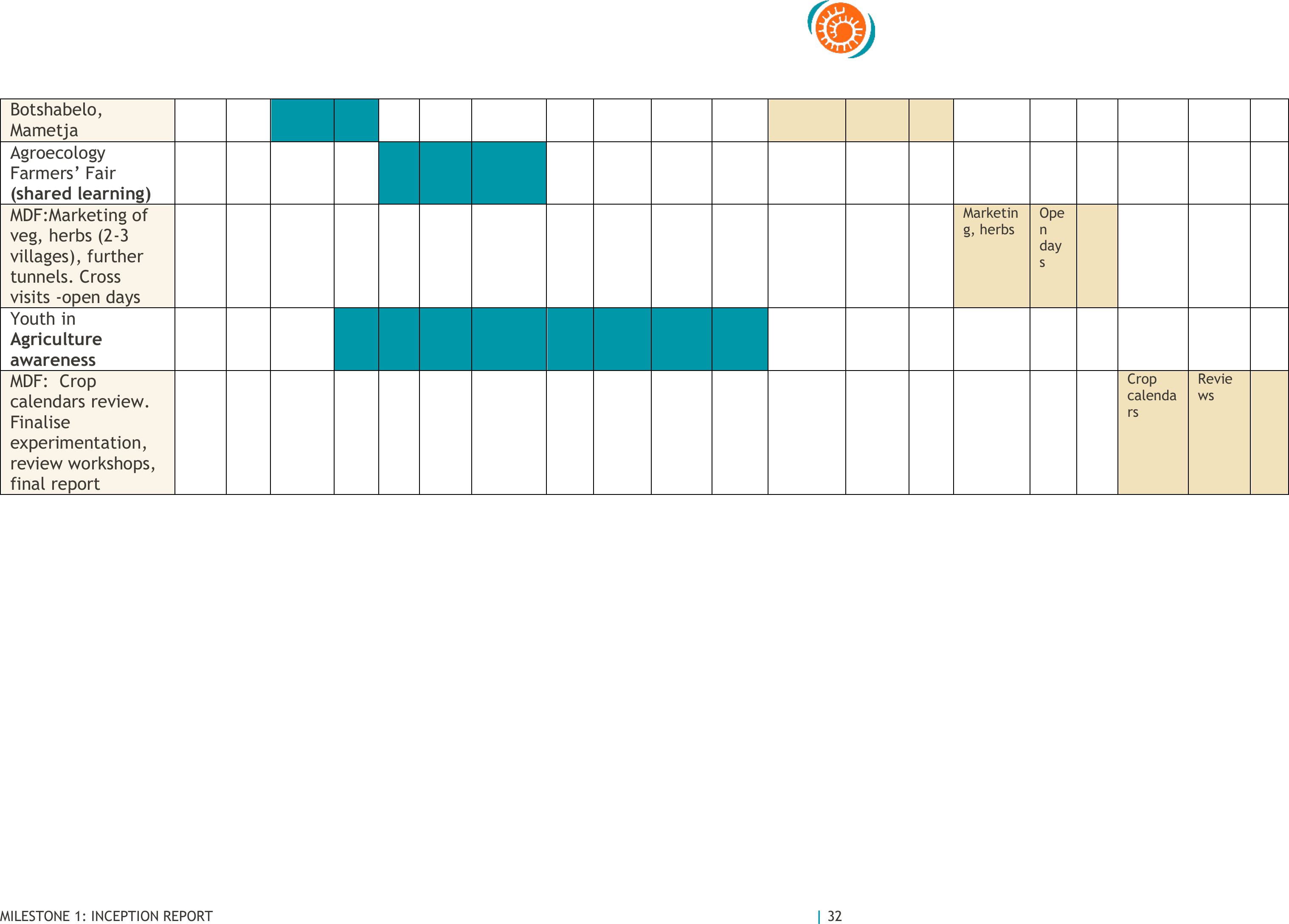
MILESTONE 1: INCEPTION REPORT
| 32
Botshabelo,
Mametja
Agroecology
Farmers’ Fair
(shared learning)
MDF:Marketing of
veg, herbs (2-3
villages), further
tunnels. Cross
visits -open days
Marketin
g, herbs
Ope
n
day
s
Youth in
Agriculture
awareness
MDF: Crop
calendars review.
Finalise
experimentation,
review workshops,
final report
Crop
calenda
rs
Revie
ws

MILESTONE 1: INCEPTION REPORT
| 33
10.2Appendix 2:
1.Bi-monthly assessment
Contributing to RESILIM-O KRA (key result area) 4: To reduce vulnerability to climate change and other
factors by supporting collective action, informed adaptation strategies and practices and tenable
Institutional arrangements.
The process of intervention with farmer participants will follow the chronology outlined below:
•Understanding current practices
•Develop a vision of what could be
•Discuss innovations and agree to try; sometimes with collaborative work
•Develop a farm design and plan that includes experimentation with new ideas
•Ongoing mentoring of implementationand experimentation
•Periodic cluster sessions
•Periodic monitoring and self-assessment
•And networking and cross visits (1 of each per year)
A.On a bi-monthlybasis photographs from all field staff is to be given captions and compiled
in one directory to be placed on drop box.
B.Regular (bi-monthly) summaries of progress using the following indicators will be made:
Indicator
Overall target
No of participants in learning groups
120
No of learning groups
6-7
No of local facilitators
6
Percentage of participants engaged in CC adaptation responses
1-2 (45%)
2-3 (25%)
>3 (10-15%)
No of participants experimenting with new innovations
-local
-co-designed
15%
45%
No of participants showing increased knowledge
35%
Percentage of participants engaged in collaborative activities
35%
Percentage of participants with improved livelihoods
-increased availability of food
-increased income
-increased diversity of activities and livelihoods options
40%
5%
5%
Qualitative assessments;
-stakeholder engagement
-Increased understanding and agency to act towards increased
resilience
- Adaptation and innovations into local context
-Potential for increased resilience
-Social engagement
Stories, case studies(5), CC
impact summaries (4), best
practices booklet
C.And there are more qualitative questions to consider that can draw out change in various
domains through systemic reflection.
BI-MONTLHY FORM…………………………..Date…………………………………Project……………………………………
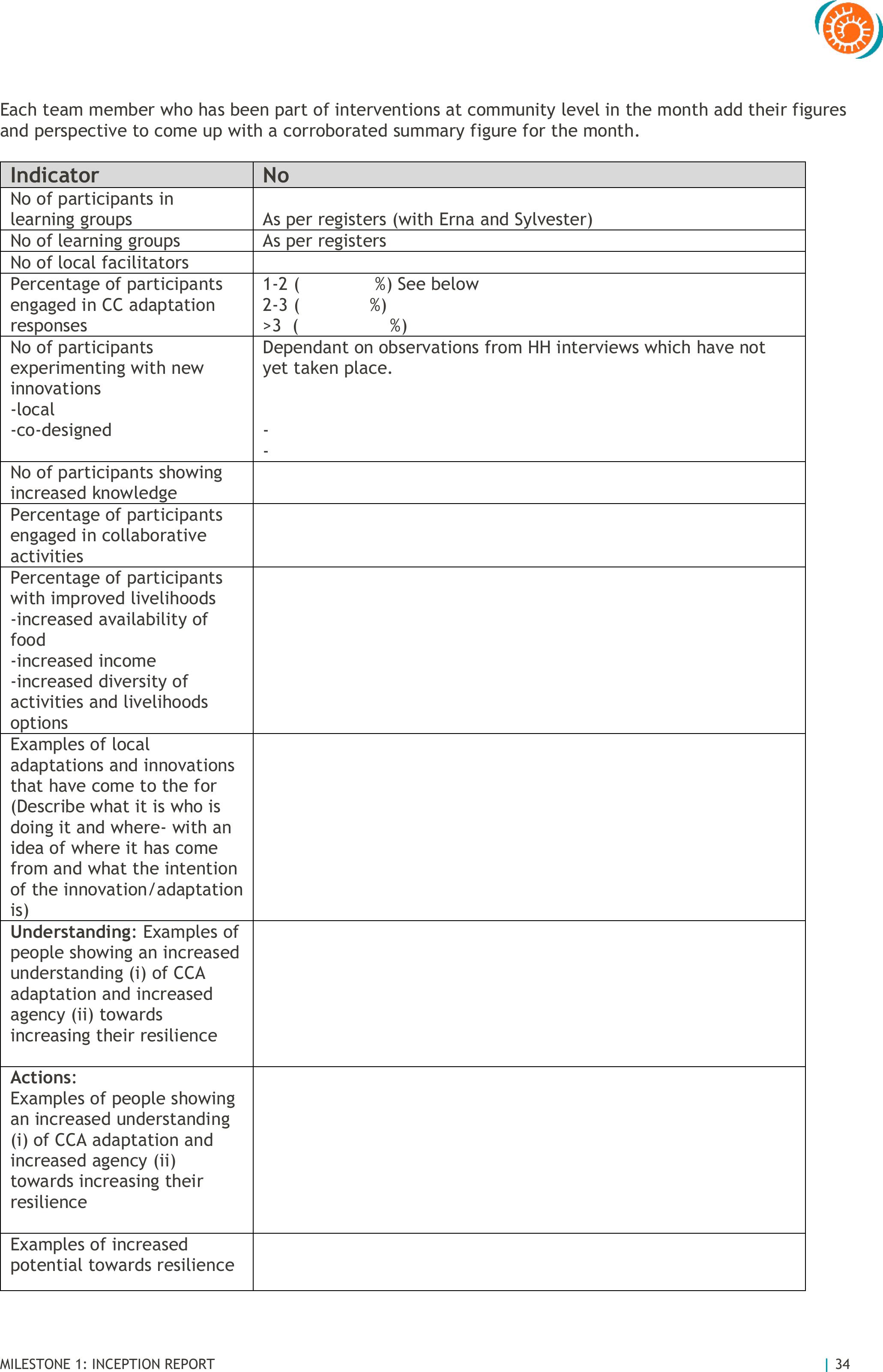
MILESTONE 1: INCEPTION REPORT
| 34
Each team member who has been part of interventions at community level in the month add their figures
and perspective to come up with a corroborated summary figure for the month.
Indicator
No
No of participants in
learning groups
As per registers (with Erna and Sylvester)
No of learning groups
As per registers
No of local facilitators
Percentage of participants
engaged in CC adaptation
responses
1-2 ( %) See below
2-3 ( %)
>3 ( %)
No of participants
experimenting with new
innovations
-local
-co-designed
Dependant on observations from HH interviews which have not
yet taken place.
-
-
No of participants showing
increased knowledge
Percentage of participants
engaged in collaborative
activities
Percentage of participants
with improved livelihoods
-increased availability of
food
-increased income
-increased diversity of
activities and livelihoods
options
Examples of local
adaptations and innovations
that have come to the for
(Describe what it is who is
doing it and where- with an
idea of where it has come
from and what the intention
of the innovation/adaptation
is)
Understanding: Examples of
people showing an increased
understanding (i) of CCA
adaptation and increased
agency (ii) towards
increasing their resilience
Actions:
Examples of people showing
an increased understanding
(i) of CCA adaptation and
increased agency (ii)
towards increasing their
resilience
Examples of increased
potential towards resilience

MILESTONE 1: INCEPTION REPORT
| 35
*For the examples the person’s name and surname and village needs to be given
2.Project Life Change Questions:
1.Do we have examples or stories of how we or others are in the process of adaptive management
related to CC? (adapt, reflect and respond to….) and examples of what this adaptive management
is?
2.Do we have stories that show innovation or lack of innovation towards positive change? What
insights have we gained into how innovation can lead to positive change?(INCREASED RESILIENCE)
3.Do we have stories that show evidence of, or an interest in self organisation towards collective
action? What insights have we gained into how self organisation can lead to collective action?
4.Do we have stories to show that learning together is happening or that there is an interest in
learning together? What insights have we gained about how to learn together?
5.Do we have stories of how we and or others are able to think systemically? What insights have we
gained?
6.Do we have stories of how we and or others are able to be inclusive and democratic? What insights
have we gained about how this can be achieved? (STAKEHOLDER ENGAGEMENT).
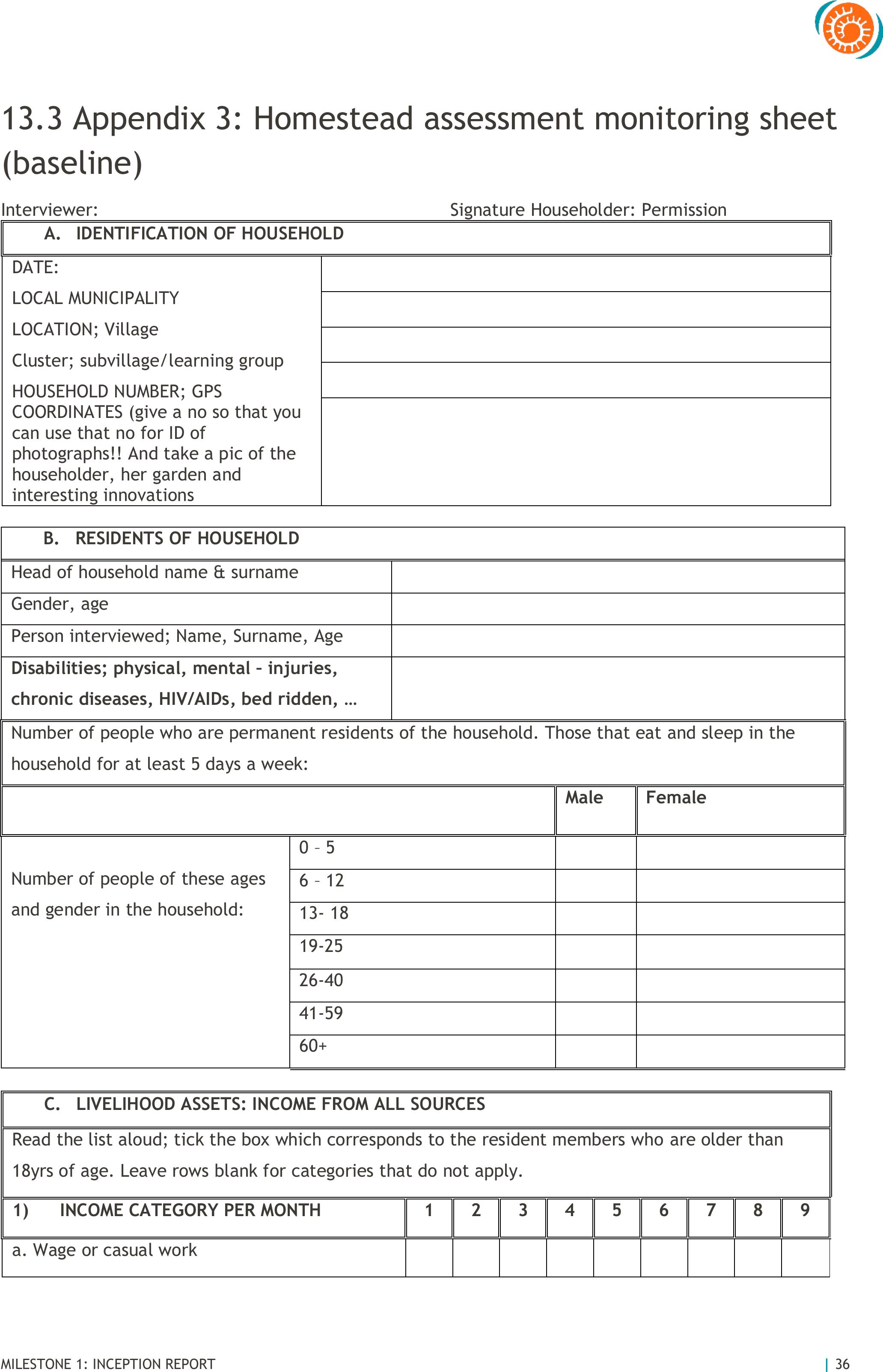
MILESTONE 1: INCEPTION REPORT
| 36
13.3 Appendix 3: Homestead assessment monitoring sheet
(baseline)
Interviewer: Signature Householder: Permission
A.IDENTIFICATION OF HOUSEHOLD
DATE:
LOCAL MUNICIPALITY
LOCATION; Village
Cluster; subvillage/learning group
HOUSEHOLD NUMBER; GPS
COORDINATES (give a no so that you
can use that no for ID of
photographs!! And take a pic of the
householder, her garden and
interesting innovations
B.RESIDENTS OF HOUSEHOLD
Head of household name & surname
Gender, age
Person interviewed; Name, Surname, Age
Disabilities; physical, mental – injuries,
chronic diseases, HIV/AIDs, bed ridden, …
Number of people who are permanent residents of the household. Those that eat and sleep in the
household for at least 5 days a week:
Male
Female
Number of people of these ages
and gender in the household:
0 –5
6 –12
13- 18
19-25
26-40
41-59
60+
C.LIVELIHOOD ASSETS: INCOME FROM ALL SOURCES
Read the list aloud; tick the box which corresponds to the resident members who are older than
18yrs of age. Leave rows blank for categories that do not apply.
1)INCOME CATEGORY PER MONTH
1
2
3
4
5
6
7
8
9
a. Wage or casual work
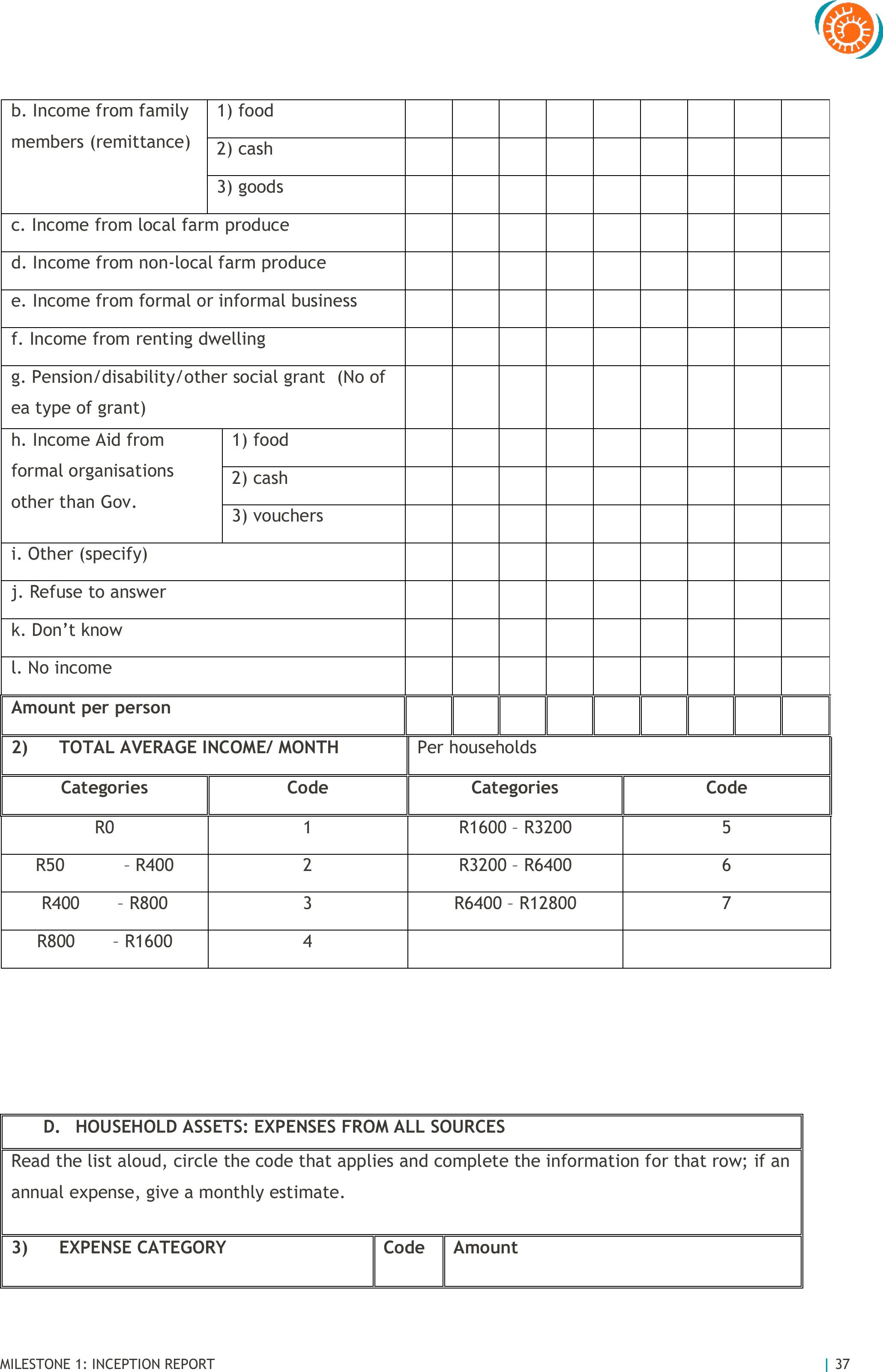
MILESTONE 1: INCEPTION REPORT
| 37
D.HOUSEHOLD ASSETS: EXPENSES FROM ALL SOURCES
Read the list aloud, circle the code that applies and complete the information for that row; if an
annual expense, give a monthly estimate.
3)EXPENSE CATEGORY
Code
Amount
b. Income from family
members (remittance)
1) food
2) cash
3) goods
c. Income from local farm produce
d. Income from non-local farm produce
e. Income from formal or informal business
f. Income from renting dwelling
g. Pension/disability/other social grant(No of
ea type of grant)
h. Income Aid from
formal organisations
other than Gov.
1) food
2) cash
3) vouchers
i. Other (specify)
j. Refuse to answer
k. Don’t know
l. No income
Amount per person
2)TOTAL AVERAGE INCOME/ MONTH
Per households
Categories
Code
Categories
Code
R0
1
R1600 – R3200
5
R50 – R400
2
R3200 – R6400
6
R400 – R800
3
R6400 – R12800
7
R800 – R1600
4

MILESTONE 1: INCEPTION REPORT
| 38
a.Food and groceries
1
Last
month
b.Utilities (water, electricity, etc)
2
Last
month
c.Transportation
3
Last
month
d.Savings
4
Last
month
e.Medical
5
Last
month
f.Education (school fees, uniforms, etc.)
6
Last
month
g.Insurance (life, burial, etc.)
7
Last
month
h.Debt service/repayment
8
Last
month
i.Other (specify type of)
9
Last
month
j.NONE
10
k.Refuse to answer
11
Garden description and size: Include a map drawing of homestead with all aspects including fencing,
water sources, fruit, windbreaks, trees, vegetables, kraals. run off, dwellings, slope, aspect, erosion:
Proportion of vegetable garden in use:- cultivated within the last 6 months (Put as a percentage)
PRESENT INFRASTRUCTURE?
Yes
No
Comments; On quantity, state, interesting
things..
a.Fencing
b.Jo-Jo tanks
c.Municipal water supply – tap in
yard – reliability- how often it
works
d.Irrigation; hoses, pipes, buckets,
bottles
e.Other – local innovations –
boreholes……..
PRESENT PRACTISES?
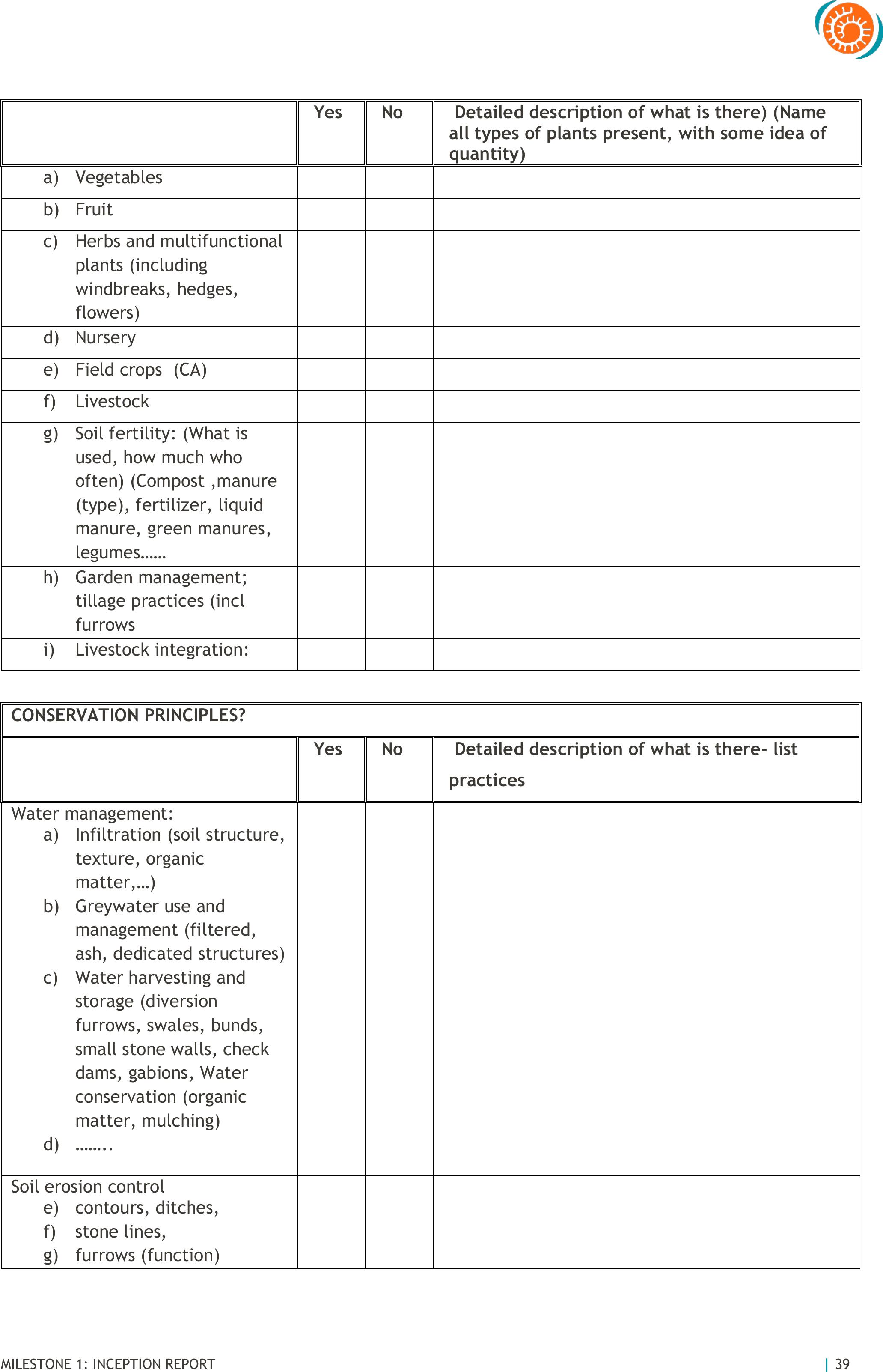
MILESTONE 1: INCEPTION REPORT
| 39
Yes
No
Detailed description of what is there) (Name
all types of plants present, with some idea of
quantity)
a)Vegetables
b)Fruit
c)Herbs and multifunctional
plants (including
windbreaks, hedges,
flowers)
d)Nursery
e)Field crops (CA)
f)Livestock
g)Soil fertility: (What is
used, how much who
often) (Compost ,manure
(type), fertilizer, liquid
manure, green manures,
legumes……
h)Garden management;
tillage practices (incl
furrows
i)Livestock integration:
CONSERVATION PRINCIPLES?
Yes
No
Detailed description of what is there- list
practices
Water management:
a)Infiltration (soil structure,
texture, organic
matter,…)
b)Greywater use and
management (filtered,
ash, dedicated structures)
c)Water harvesting and
storage (diversion
furrows, swales, bunds,
small stone walls, check
dams, gabions, Water
conservation (organic
matter, mulching)
d)……..
Soil erosion control
e)contours, ditches,
f)stone lines,
g)furrows (function)
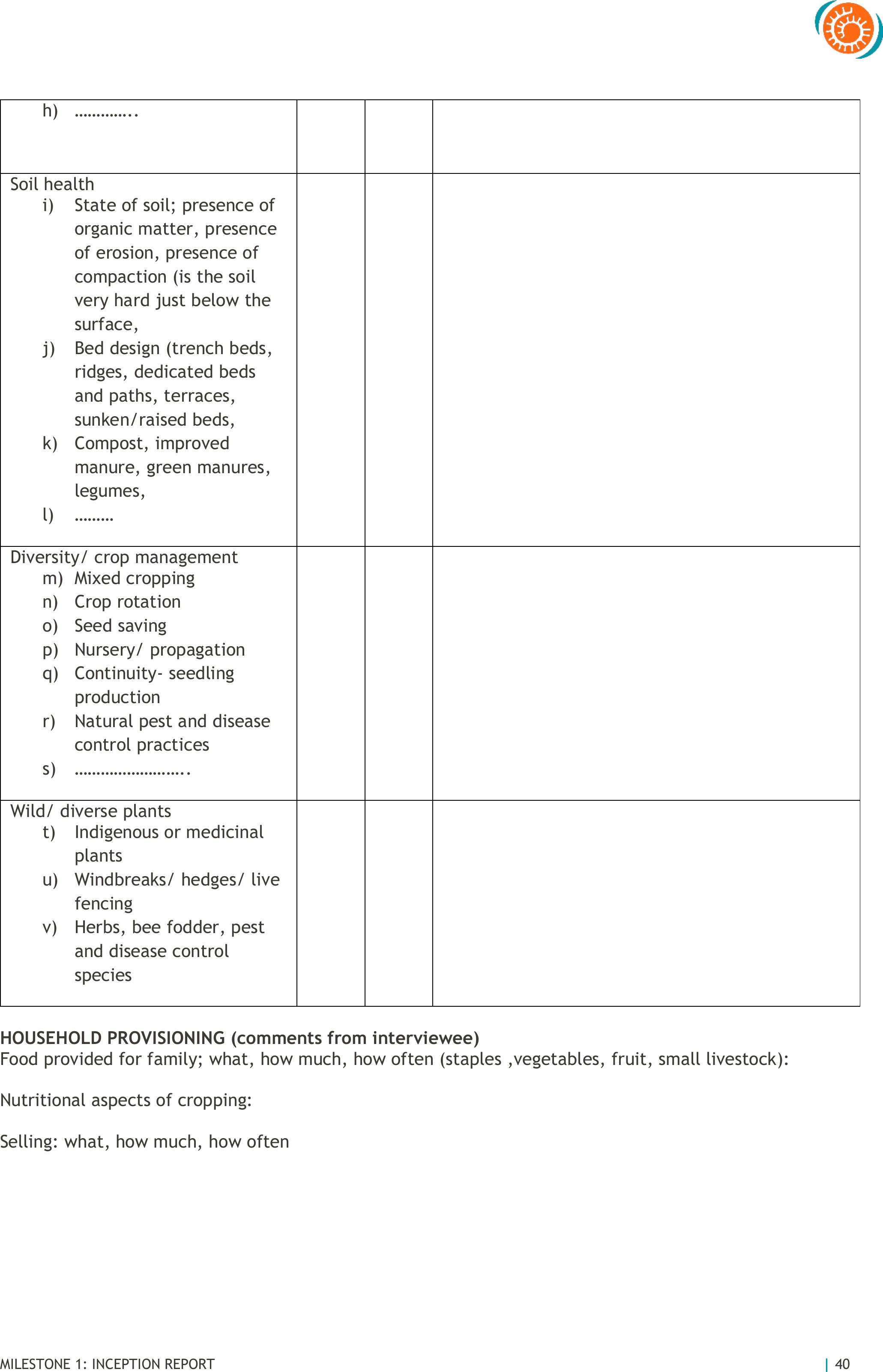
MILESTONE 1: INCEPTION REPORT
| 40
h)…………..
Soil health
i)State of soil; presence of
organic matter, presence
of erosion, presence of
compaction (is the soil
very hard just below the
surface,
j)Bed design (trench beds,
ridges, dedicated beds
and paths, terraces,
sunken/raised beds,
k)Compost, improved
manure, green manures,
legumes,
l)………
Diversity/ crop management
m)Mixed cropping
n)Crop rotation
o)Seed saving
p)Nursery/ propagation
q)Continuity- seedling
production
r)Natural pest and disease
control practices
s)……………………..
Wild/ diverse plants
t)Indigenous or medicinal
plants
u)Windbreaks/ hedges/ live
fencing
v)Herbs, bee fodder, pest
and disease control
species
HOUSEHOLD PROVISIONING (comments from interviewee)
Food provided for family; what, how much, how often (staples ,vegetables, fruit, small livestock):
Nutritional aspects of cropping:
Selling: what, how much, how often
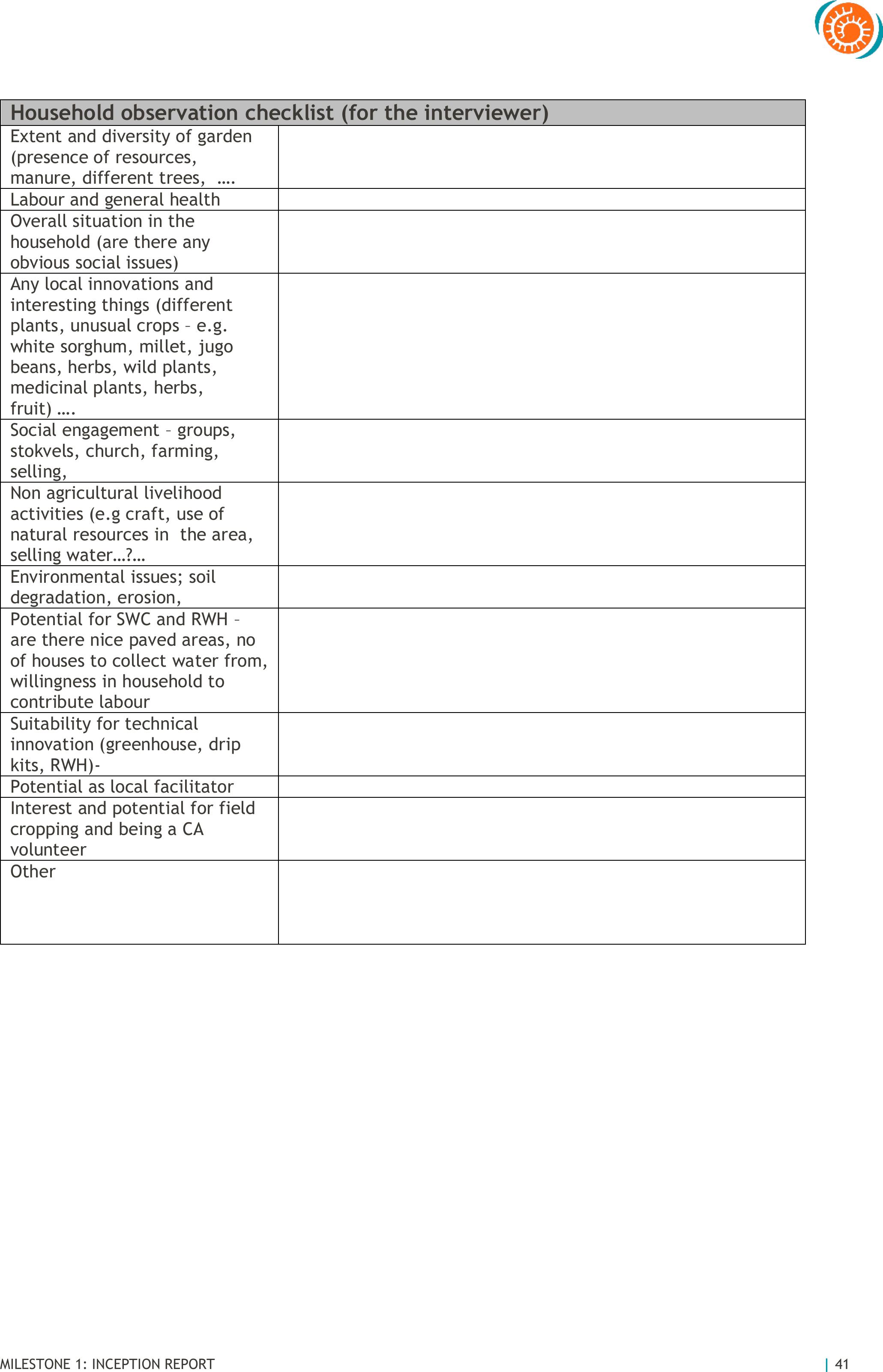
MILESTONE 1: INCEPTION REPORT
| 41
Household observation checklist (for the interviewer)
Extent and diversity of garden
(presence of resources,
manure, different trees, ….
Labour and general health
Overall situation in the
household (are there any
obvious social issues)
Any local innovations and
interesting things (different
plants, unusual crops – e.g.
white sorghum, millet, jugo
beans, herbs, wild plants,
medicinal plants, herbs,
fruit) ….
Social engagement – groups,
stokvels, church, farming,
selling,
Non agricultural livelihood
activities (e.g craft, use of
natural resources in the area,
selling water…?…
Environmental issues; soil
degradation, erosion,
Potential for SWC and RWH –
are there nice paved areas, no
of houses to collect water from,
willingness in household to
contribute labour
Suitability for technical
innovation (greenhouse, drip
kits, RWH)-
Potential as local facilitator
Interest and potential for field
cropping and being a CA
volunteer
Other
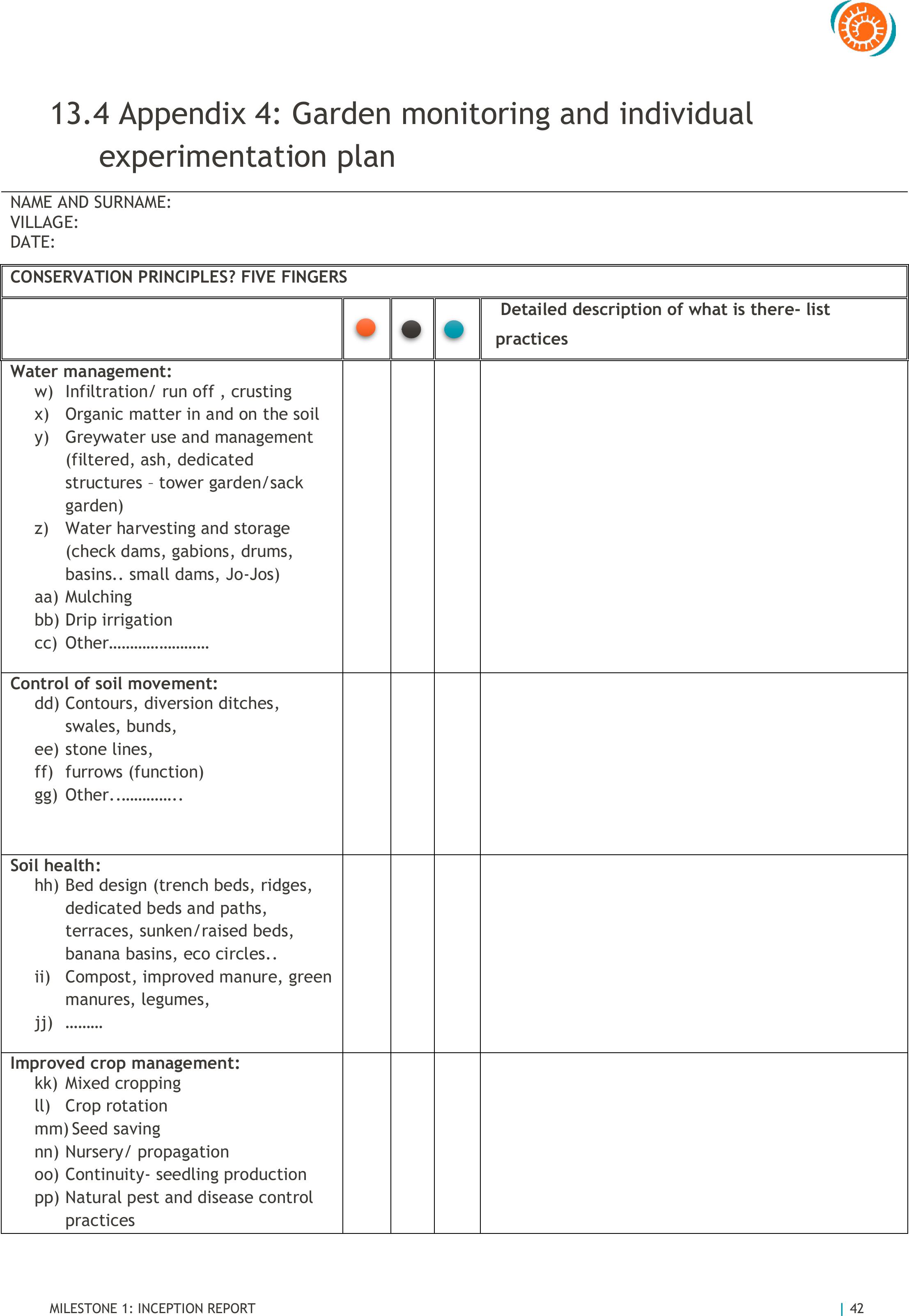
MILESTONE 1: INCEPTION REPORT
| 42
13.4 Appendix 4: Garden monitoring and individual
experimentation plan
NAME AND SURNAME:
VILLAGE:
DATE:
CONSERVATION PRINCIPLES? FIVE FINGERS
Detailed description of what is there- list
practices
Water management:
w)Infiltration/ run off , crusting
x)Organic matter in and on the soil
y)Greywater use and management
(filtered, ash, dedicated
structures – tower garden/sack
garden)
z)Water harvesting and storage
(check dams, gabions, drums,
basins.. small dams, Jo-Jos)
aa)Mulching
bb)Drip irrigation
cc)Other……………………
Control of soil movement:
dd)Contours, diversion ditches,
swales, bunds,
ee)stone lines,
ff)furrows (function)
gg)Other..…………..
Soil health:
hh)Bed design (trench beds, ridges,
dedicated beds and paths,
terraces, sunken/raised beds,
banana basins, eco circles..
ii)Compost, improved manure, green
manures, legumes,
jj)………
Improved crop management:
kk)Mixed cropping
ll)Crop rotation
mm)Seed saving
nn)Nursery/ propagation
oo)Continuity- seedling production
pp)Natural pest and disease control
practices
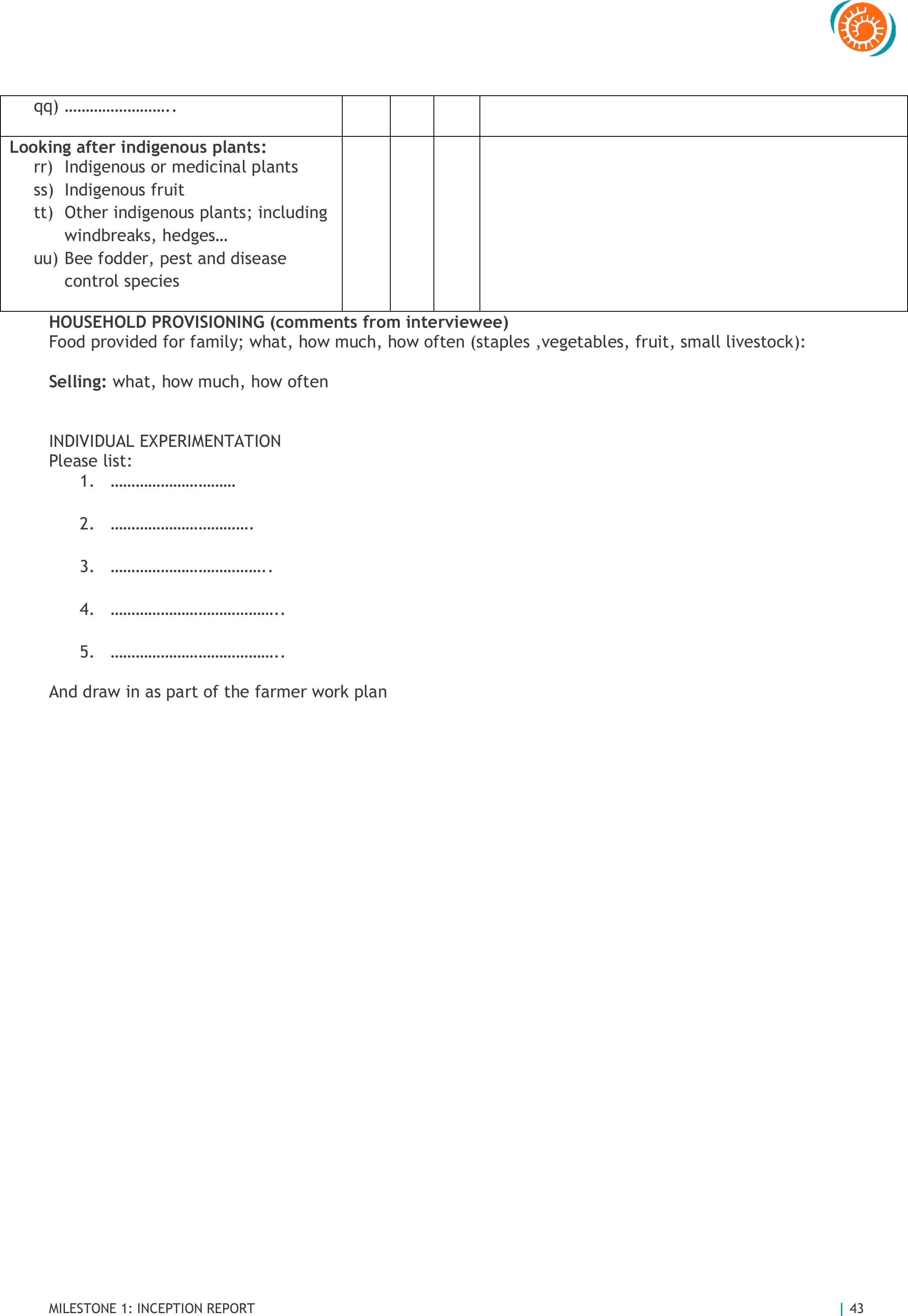
MILESTONE 1: INCEPTION REPORT
| 43
qq)……………………..
Looking after indigenous plants:
rr)Indigenous or medicinal plants
ss)Indigenous fruit
tt)Other indigenous plants; including
windbreaks, hedges…
uu)Bee fodder, pest and disease
control species
HOUSEHOLD PROVISIONING (comments from interviewee)
Food provided for family; what, how much, how often (staples ,vegetables, fruit, small livestock):
Selling: what, how much, how often
INDIVIDUAL EXPERIMENTATION
Please list:
1.…………………………
2.…………………………….
3.………………………………..
4.…………………………………..
5.…………………………………..
And draw in as part of the farmer work plan

MILESTONE 1: INCEPTION REPORT
| 44
13.5 Appendix 5: Attendance registers for CA
demonstration workshops: December 2017- Turkey,
Mametje and Botshabelo.

MILESTONE 1: INCEPTION REPORT
| 45
13.6 Appendix 6: Establishment of CA trial or experimental
sites
Three conservation agriculture (CA) trials were established in the rural communities of Mametja in the
Limpopo province. In recent years, this area has been characterized by low and erratic rainfall.These
trials were established to evaluate how CA performs under extreme weather conditions (high
temperatures, low and erratic rainfall) faced in the area as compared to traditional farming practices
(conventional tillage). Some of the parameters to be evaluated are water productivity and social
acceptability and yield. With the area having received 150 mm in the 2016/2017 growing season CA trials
did not perform well under these conditions. The trials were established in 3 fields, situated in Sedawa
(Koko Maphori), Mametja (at Lerato Lewele) and Botshabelo (Seemole Malepe). The trials were planted by
members of the learning group, and this was organized in the form of a workshop of CA and the trial sites
are going to be used as demonstration sites. The soil type is almost completely different at each of the
sites which might make the results more representative of the area. Soil fertility samples were taken at
these plots, as well as gravimetric water soil samples. Run-off plots and rain gauges were also installed.
13.6.1 Trial size and layouts
The trial sizes were kept at the same size for all three participants and the layouts are as shown in the
diagrams below. The size of individual plots is 10 m2 and the total trial size is 1000 m2.
Figure 1. CA trial layout for Koko Maphori’s field (N.B plots highlighted in brown is where runoff
plot have been installed)
13.6.2. Progress of Koko Maphori’strial plots
Winter cover
crops
Sunflower
Maize +
Cowpea
Maize +
Cowpea
Maize +Beans
Maize
Maize
Maize +
Beans
Sunflower
Sunflower +
millet
Gate
Rain gauge
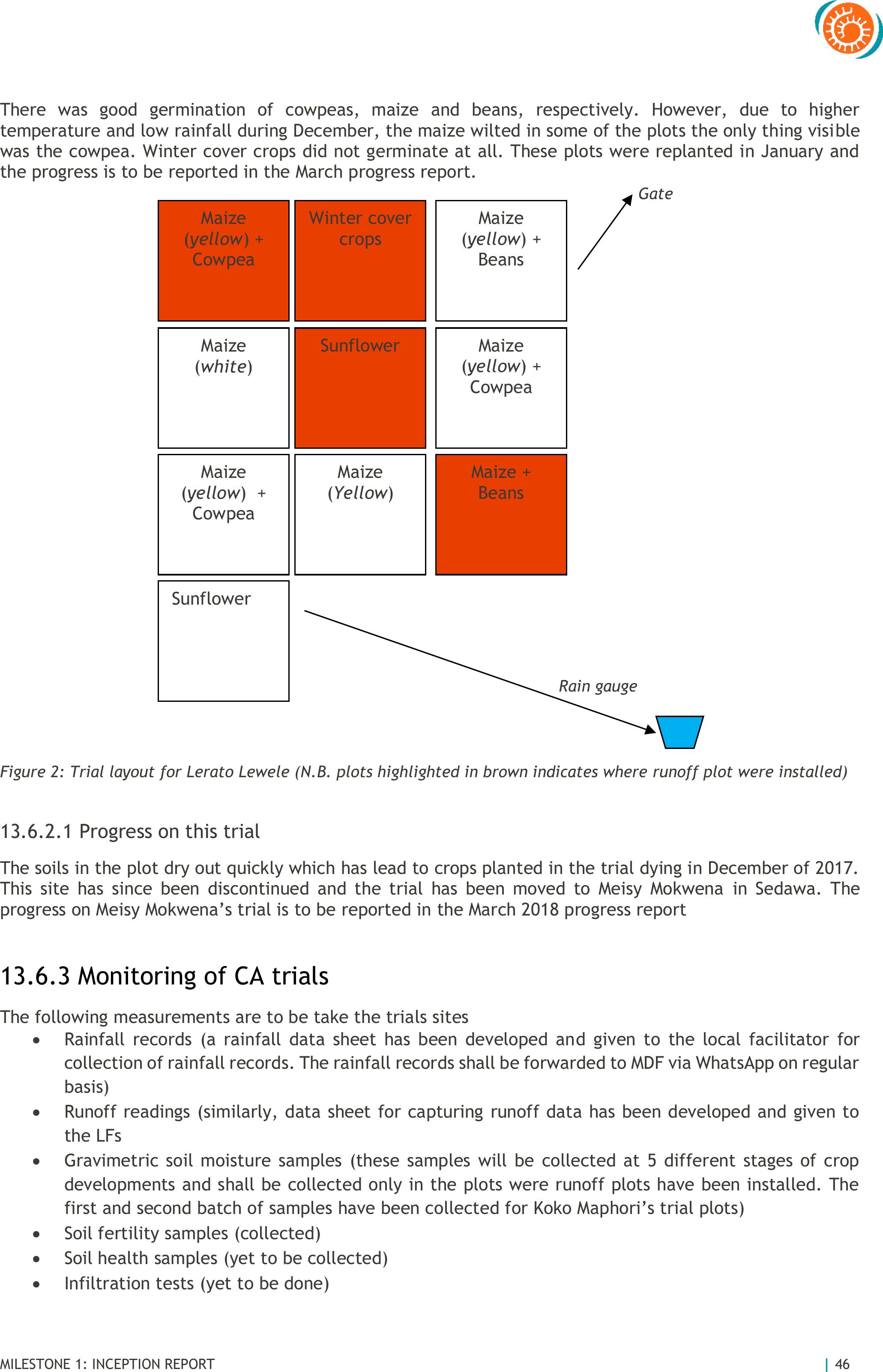
MILESTONE 1: INCEPTION REPORT
| 46
There was good germination of cowpeas, maize and beans, respectively. However, due to higher
temperature and low rainfall during December, the maize wilted in some of the plots the only thing visible
was the cowpea. Winter cover crops didnot germinate at all. These plots were replanted in January and
the progress is to be reported in the March progress report.
Figure 2: Trial layout for Lerato Lewele (N.B. plots highlighted in brown indicates where runoff plot were installed)
13.6.2.1 Progress on this trial
The soils in the plot dry out quickly which has lead to crops planted in the trial dying in December of 2017.
This site has since been discontinued and the trial has been moved toMeisy Mokwena in Sedawa. The
progress on Meisy Mokwena’s trial is to be reported in the March 2018 progress report
13.6.3 Monitoring of CA trials
The following measurements are to be take the trials sites
•Rainfall records (a rainfall data sheet has been developed and given to the local facilitator for
collection of rainfall records. The rainfall records shall be forwarded toMDFvia WhatsApp on regular
basis)
•Runoff readings (similarly, data sheet for capturing runoff data has been developed and given to
the LFs
•Gravimetric soil moisture samples (these samples will be collected at 5 different stages of crop
developments and shall be collected onlyin the plots were runoff plots have been installed. The
first and second batch of samples have been collected for Koko Maphori’s trial plots)
•Soil fertility samples (collected)
•Soil health samples (yet to be collected)
•Infiltration tests (yet to be done)
Maize
(yellow) +
Cowpea
Winter cover
crops
Maize
(yellow) +
Beans
Maize
(white)
Sunflower
Maize
(yellow) +
Cowpea
Maize
(yellow) +
Cowpea
Maize
(Yellow)
Maize +
Beans
Sunflower
Gate
Rain gauge

MILESTONE 1: INCEPTION REPORT
| 47
•Soil structure tests (yet to be done)
Priority and attention has been given to collection gravimetric soil moisture samples, because these samples
are time specific and required alot of attention andare more labour intensive. Gravimetric soil moisture
samples have been discontinued in plots that had to be replanted and new samples need to be collected at
the right stages ofcrop development. Gravimetric water samples were collected at planting in 2 of the sites,
namely Lerato Lewele and Koko Mapori ‘s fields.An a second setof gravimetricwater samples were
collected at Koko Maphori’s plot in early January of 2018.
Summary:
LF Christina Thobejane with assistance from Alex will be responsible for monitoring of the CA trial sites
(we advised other participants be involved in monitoring as a way of learning about indicators to be
measured)

MILESTONE 1: INCEPTION REPORT
| 48